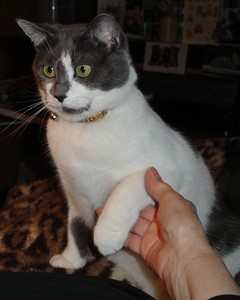 We introduced Bobbi Florio Graham Monday in Part 1 of this series. To remind you, Barbara (Bobbi) Florio Graham won the $1,000 Sticky Paws award for best article on training at the Cat Writers’ Association annual conference in 2002.
We introduced Bobbi Florio Graham Monday in Part 1 of this series. To remind you, Barbara (Bobbi) Florio Graham won the $1,000 Sticky Paws award for best article on training at the Cat Writers’ Association annual conference in 2002.
Over the last two days, she shared some basics about training and introduced us to her original cat, Simon Teakettle and the two cats who followed him. Today, she’ll focus on her current cat, who is in training as we speak.
Training Q.T. Penny was a bit more difficult because she was a year old when I adopted her. But I continued to use the same commands that brought results with my previous cats. These include “Come here,” “Sit,” “Stay,” and “No!”
When I pick up a kitten to do something pleasant, to pet, brush, or even to move gently off my lap so I can get up, I use my left hand under her belly, with my right hand petting her.
Penny didn’t like to be picked up, and it took a full year of my gentle persuasion to get her to understand that nothing bad was going to happen. Now, she permits me to do everything, including to brush her teeth!
She considers her toothbrush a toy. She also likes to have me trim her claws. That came about because she seemed interested when I used my nail clippers. I began to use them to clip her claws when she was on my lap, and I gradually introduced the cat clippers. At the beginning, I could only clip one or two claws at a time, but now we do both front paws in one sitting.
Penny has a large and growing vocabulary. Teaching words is a matter of consistency. Use the same words, in short phrases, repeat frequently, and use hand or body signals to reinforce the message.
In addition to the basic commands, I’ve taught Penny words she associates with pleasant activities. She understands “Lap,” and comes immediately when I say “Brush” or “Treat.”
She understands “ball” and “toy” although I’m not sure she knows which is which! But she definitely knows “Mouse.” If I ask her where her mouse is, she goes to find it. And I’m not sure if it’s her instinct or my command that has her respond to “Catch” when I toss her a toy. But I praise that anyway.
One of the newer phrases Penny has leaned is “Excuse me.” When I say this, she jumps off my lap, knowing I want to get up.
I’m always shocked to hear from friends whose cats wake them up at ungodly hours, wanting to be fed. Why would you allow that?
My solution is to feed Penny only twice a day, late in the morning, and just before I have my evening meal. If I’m going out for dinner, I either feed her before I leave, or make sure her dishes of dry food are full.
The key to sleeping as late as you want is to ensure the cat has dry food to eat whenever she wishes. I feed two high-quality dry foods, one with large pieces to help with dental care, and the other a grain-free weight-management formula.
Since I used the latter as substitute treats when I first began to train her, this food is associated with pleasure as well as sustenance.
Every cat I’ve had understood and adapted to my daily habits. Usually, when I wake up, Penny is beside me, and begins to beg me to pet her when she senses I’m awake.
Similarly, cats know the signals that indicate bedtime preparation. Include the cat in these as much as possible, using the word “Bed” if you allow the cat to sleep with you.
Penny has just started to do what Terzo used to do: jump on the bed and wait for me when she realizes I’m heading in that direction.
If the cat is supposed to sleep in another location, put her there, pet and praise her, using the word “Bed.”
Don’t underestimate your cat’s vocabulary. It takes patience to teach them, but it’s not only rewarding, it’s fun to see how much they can learn.
Barbara Florio Graham is an author and publishing consultant whose business is named after The Cat Who Owns the Company. Her website: http://simonteakettle.com contains Simon Teakettle’s blog, fan club, and a great deal of information about cats (as well as many other subjects).





